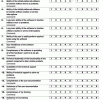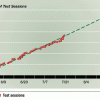People & Teams
Better Software Magazine Articles
|
The Human Side of Process Improvement Interpersonal relationships can make the difference between effective and ineffective technical initiatives. Here are ways to address this frequently neglected aspect of organizational change. |
Judah Mogilensky
June 26, 2002 |
|
|
|
Getting the Most from Outsourcing Outsourcing can be a great way to augment your software efforts. Here are guidelines to help you choose the right provider and ensure that you get what you paid for. |
Eric Patel
June 26, 2002 |
 |
Customer Satisfaction: What to Ask, How to Ask, and Who to Ask Improving customer satisfaction should be a primary goal of process improvement programs. So how satisfied are our customers? One of the best ways to find out is to ask them. Here are techniques for creating a useful survey and interpreting the results. |
Linda Westfall
June 26, 2002 |
|
Escaping the Clutches of Zombie Projects Timely and accurate information is often your only silver bullet against interminable and doomed projects. Learn how to deliver bad news in such a way that Senior Management hears it and acts promptly. |
||
 |
Juggling Concurrent Releases Every day you are faced with juggling resources and attention between customer escalations, current development projects, and planning for the future. With development cycles measured in weeks, you have at least three releases for each product. Multiply that by the number of projects under your responsibility, and you have a dozen or more releases to manage simultaneously. |
Neal Reizer
June 26, 2002 |
|
Matching ISO 9000 Registration to Your Organization The chances of getting use from your ISO 9000 certification are greatly enhanced by a registration effort that reflects the real goals and operating principles of your organization. Here are some lessons on how to tailor your effort. |
Mark Johnson
June 26, 2002 |
|
 |
Perspectives from a Test Manager: Four Keys to Keeping Your Testing on Track This article highlights four keys to getting better organized: 1. A common set of ground rules on the test progress, defect reporting, and verification; 2. The ability to convey how your team’s testing is going--on a frequent basis; 3. Knowing what needs to be tested--and being able to stand behind the reasons why; 4. Maintaining good communication with the development leaders to help move the product through the development phases--being proactive rather than reactive. |
|
 |
Session-Based Test Management: A Strategy for Structuring Exploratory Testing Unlike traditional scripted testing, exploratory testing is an ad hoc process. Everything we do is optimized to find bugs fast, so we continually adjust our plans to refocus on the most promising risk areas; we follow hunches; we minimize the time spent on documentation. That leaves us with some problems. For one thing, keeping track of each tester’s progress can be like herding snakes into a burlap bag. Every day I need to know what we tested, what we found, and what our priorities are for further testing. |
|
|
Your Piece of the Pie More than 1,800 industry professionals responded to the third annual STQE/StickyMinds salary poll. The results suggest that, although it has been an unsettling year, the picture doesn't look all that bad for software QA professionals. |
Alyn Wambeke
June 26, 2002 |
|
|
The Quality Barometer A QA manager is often faced with measuring the impossible. Here is a simple, post-ship metric to help judge the test effort's effectiveness. The Quality Barometer method uses the bug counts found during testing, calculates a percentage, and then uses that percentage as the defect target number that can be tolerated after shipment. |
George Hamblen
June 26, 2002 |





